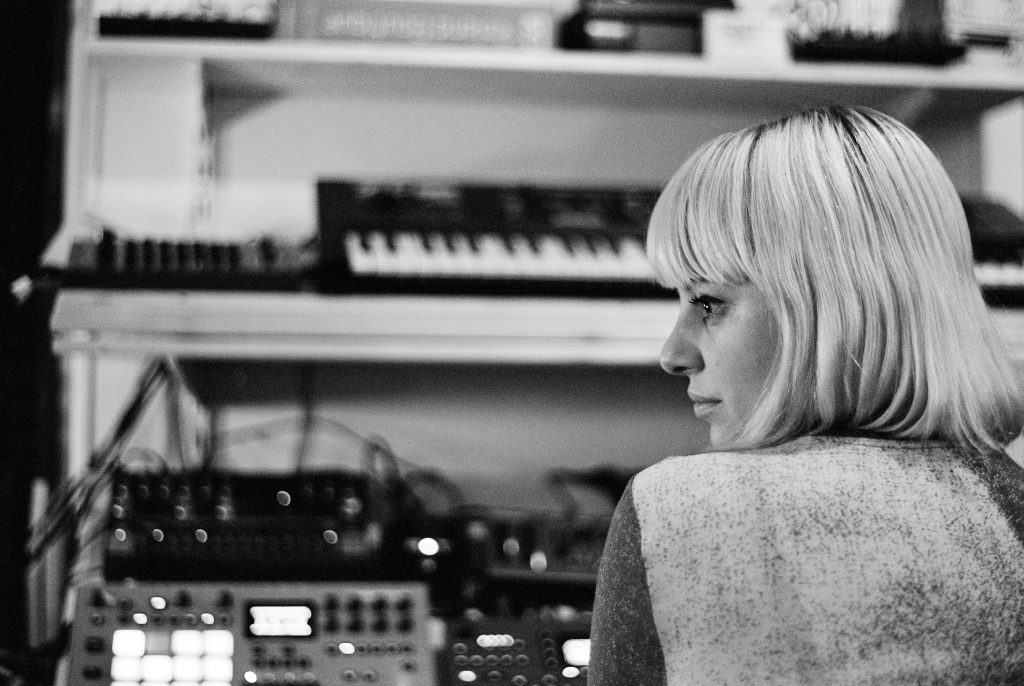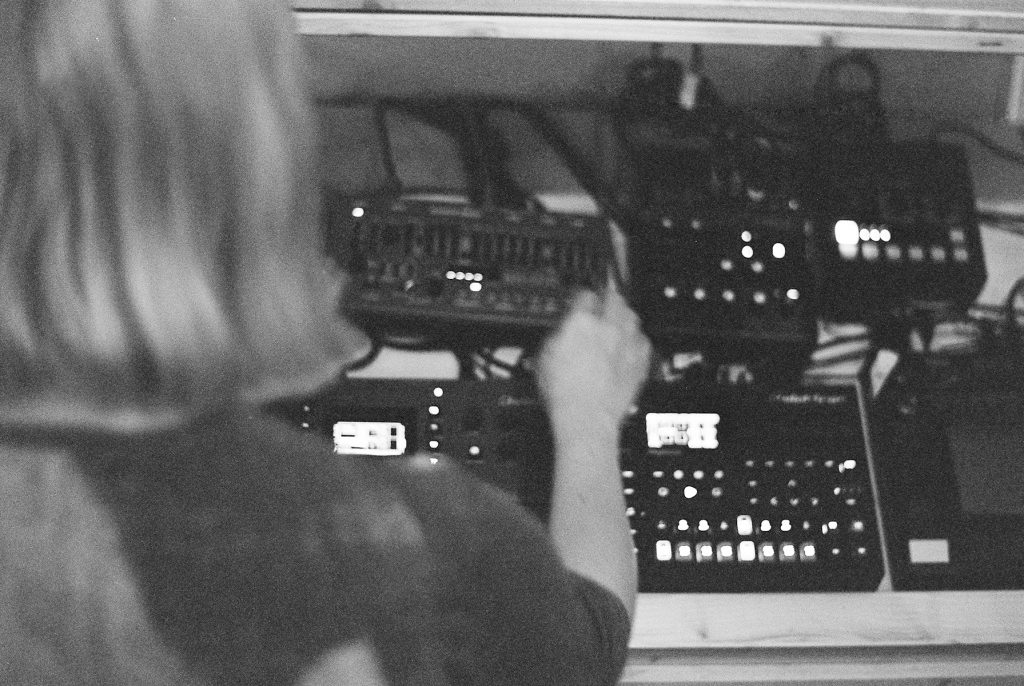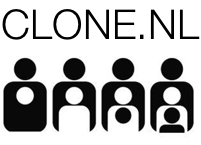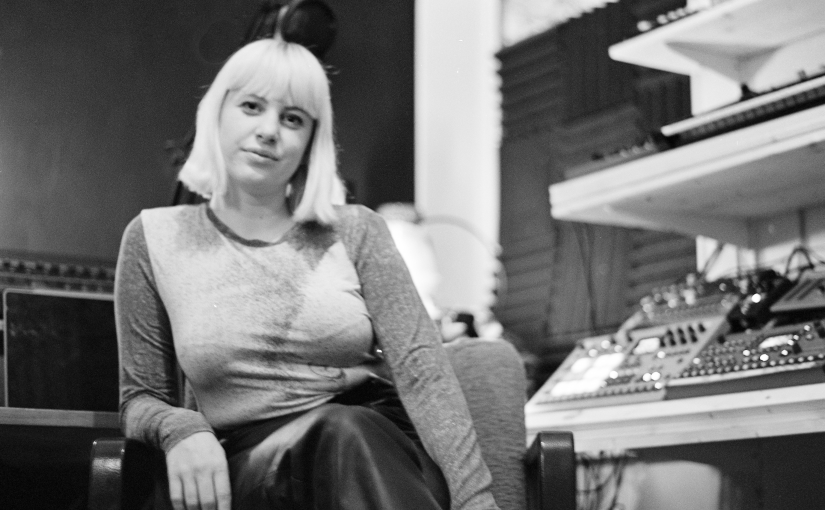Alberta Balsam is a sonic world builder. A classically trained musician who graduated from the conservatory, her approach is both deeply technical and imaginatively rich. Utilising vintage hardware alongside Ableton wizardry, she recalls early electronic experiments while also tuning into cosmic frequencies that extend beyond time and space.

Out on Clone/Dub Recordings this month, 15 Billion Elektrovolt is no exception. Skyrocketing through sizzling acid, dreamy IDM and sawtooth electro, the EP delivers 7 potent tracks, punctuated by cavernous, rolling drums and spacious melodies. From the florid textures of ‘The Mandragora’ to the wonky, warbling bass of ‘Nibiru Desert’, ’15 Billion Elektrovolt’ transmits a star-bound energy that conjures visions of oceanic depths, far-off galaxies and distant horizons.
Catching up to discuss the release, our conversation dips into the analogue equipment that’s a signature of Alberta’s style – and which she uses as part of her mind-bending live showcases – drawing influence from the halcyon 1990s and the intricacies of production.
Hannah Pezzack: Your debut EP Higher Dreams – released by Dekmantel in 2021 – is inspired by the sci-fi novelist Ursula K Le Quin, and weaves a narrative of climate collapse, redemption and hope in the wake of chaos. Does this record have a similar conceptual underpinning?
Alberta Balsam: There’s no overarching narrative, but I often find myself inventing a world when I’m in the studio. I always have a visual accompaniment in my mind, like watching a movie. For instance, in the background of ‘Comic Bionic’, there are lots of laughing people, but the voices are synthesised through vocoders so they are really robotic. The track is about these androids moving through the city, causing chaos, on the way to a rave. Then ‘Galactic Gambol’ is a coming-of-age narrative; it imagines this cute, young character going out into the world and having an adventure. The process is quite cinematic, in a sense. Something that runs through all my music is this sense of optimism; a feeling of hopefulness.
HP: The vocals are beautifully subtle. There are these flashes of ghostly, computerised voices intertwined with the beats.
AB: Actually, I always try to forefront my vocals. But it often makes the track sound too poppy. So I wind up cutting them up and they vanish into the background or even disappear completely. Of course, there’s something rather beautiful about pop singing, especially when it’s got this ethereal, almost soothing quality. It’s interesting, isn’t it? Sometimes you have these go-to or automatic modes of making. Like the way you programme your drums or the chords you choose or the vocal style – these aspects are quite instinctual for me. It just feels right.
HP: Can you walk me through the equipment you used on the EP?
AB: I use a combination of vintage equipment and Ableton. I always mix in Ableton because it’s easier, but I use a lot of hardware at my gigs. Lately, I’ve been playing with my JX-3P, which I had just bought when I was making these tracks. So that instrument is really prevalent on the EP as well as my Moog which I used for samples. I was aiming for the release to have this more impactful, clubby feel, so I was looking for new equipment to work with.
 They call the JX-3P the poor man’s Juno. It’s a Roland from the 1980s, but it hasn’t got any faders or anything. It’s such a pain in the ass to program. But you can use Ableton together with midi to control it, which is super cool. It’s a very nerdy approach that I love.
They call the JX-3P the poor man’s Juno. It’s a Roland from the 1980s, but it hasn’t got any faders or anything. It’s such a pain in the ass to program. But you can use Ableton together with midi to control it, which is super cool. It’s a very nerdy approach that I love.
At times, I feel so overwhelmed by all the machines in my studio like I have too many options. For instance, with my Octatrack, I feel I’m not using it to its full potential. I have that with a lot of my gear. But then, I’ll be playing around with something, after a couple of years of owning it, and it will open up to me and I’ll understand every part of it. I think that comes with viewing the instrument as a toy.
HP: Unlike many electronic musicians, you are able to read sheet music and have training in composition. Does that ever come in handy in your production process?
AB: There’s a track on the EP – ‘The Mandragora’ – which has a very theoretical approach. It’s structured around these Plaid style, complicated chord patterns. And it isn’t in 16 or 32 bars, but rather 20. It was a way of working that felt creatively inspiring, although I’m not sure my background in composition always helps me. I want things to be dark, underground and heavy hitting, but making intricate melodies doesn’t seem to go hand-in-hand with that. It can make the music sound too polite or sweet. Then again, that is my training, it’s what I’m drawing on and what influences me. And all theories of music, all approaches, are connected.
 HP: To me, your sound is so rooted in the 1990s. I immediately think of Autechre’s ambient techno and, of course, Aphex Twin, where your namesake comes from, but also acts like Luke Vibert’s project Wagon Christ or electro-icons Dopplereffekt. What draws you to this era?
HP: To me, your sound is so rooted in the 1990s. I immediately think of Autechre’s ambient techno and, of course, Aphex Twin, where your namesake comes from, but also acts like Luke Vibert’s project Wagon Christ or electro-icons Dopplereffekt. What draws you to this era?
AB: It’s wonderful to refer back to that decade because you play with familiarity while finding space to add experimental elements. It seems as if a certain recognisability opens a door to exploring weirder, more leftfield things. Although what draws me towards the 1990s, particularly the IDM movement, isn’t so much the sound, but rather the fact that artists made such beautiful, deeply touching music with such minimal means. It seemed to be this hugely creative moment in history, and I’m concerned that we’re not as sensitive these days. Or perhaps receptivity is still there, as an undercurrent, but it doesn’t surface as much.
HP: How do you see the release in relation to the other records out on Clone/Dub Recordings?
AB: The label feels like a really good fit, given that Rotterdam is my hometown. I’m a big fan of Exshaw by Ryan James Ford, for instance. I’m pretty proud to be alongside that album.
Alberta Balsam – 15 Billion Elektrovolt – Dub Recordings 050 shipping from clone.nl early June 2023
All photos by Laetitia Bosma.

